Green Spotlight: Grow and Give with the High Desert Food and Farm Alliance
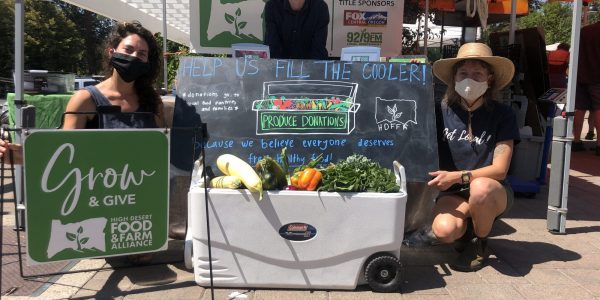
In Deschutes County, 1 in 8 people across the County is food insecure, meaning they don’t always know where their next meal will come from. At the same time, an estimated 26% of our landfill (the one that is projected to be full by 2029) is comprised of wasted food. The High Desert Food and Farm Alliance’s (HDFFA) Grow and Give program offers one unique solution at these crossroads.
Here’s how it works – In the summer months, Grow and Give Farmers Market Team collects donations from farmers and patrons at the Downtown Bend and NWX farmers markets. Throughout the year, the Harvest Teams collect excess food from farmers’ fields. In 2021 so far, the program has collected over 17,000 pounds of fresh produce from farmers, gardeners, and market patrons. This produce is then distributed to hunger relief agencies throughout the tri-county area by NeighborImpact. Much of this produce would have otherwise been composted or fed to livestock. I got a chance to chat with Rachel Levy and Caroline Danielson at HDFFA to learn more.
Here’s our conversation…
UA: Thanks for joining me today! To start, can you introduce yourselves and share about your roles in the Grow & Give as an overview of the program? and hare about your roles and an overview of how the program started and has evolved?
RL: I’m Rachel Levy, she/her pronouns. I’m the Community Food Access Coordinator, which means I make sure the nuts and bolts of the program are falling into place, whether that’s working on a team with Vista and Market Support to run farmers markets or gleaning events and making sure we have volunteers lined up. This program uses most the most volunteers out of all our programs. We have volunteers gleaning on farms and doing collection at farmers’ markets.
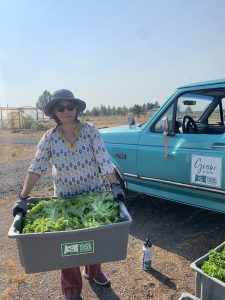
Another big piece is expanding the program. The past 3 years and the next 3 years have been funded by the USDA Community Food Program. The program began in 2016 and has been running smooth in Bend and Deschutes County. It is a Central Oregon program so making sure we are serving Jefferson and Crook County. A big thing this year, has been fostering relationships in Prineville that we have developed over the years. The program in Prineville was community led, then we provide resources and support needed. We are working on a similar process for expanding in Madras to work with community based leaders to identify the needs, then offering support.
I do go on a lot of gleans to harvest in the soil. Fostering relationship NeighborImpact, which is 100% key to program happening. NeighborImpact has over 50 pantries they distribute to. Most of the food we collected in Bend, NWX and from farmers gets distributed by NeighborImpact. What’s collected in Prineville stays in Prineville. Always in talks with what we have an what produce we have and what we’re getting and if we have enough bins and trucks.
CD: I’m Caroline Danielson, she/her pronouns. I started with HDFFA in July 2020, collecting in Bend and NWX Farmers doing just Grow and Give. I then started in AmeriCorps Vista role to support capacity building across HDFFA, but still work closely with Grow and Give. One of my main focusses has been expanding Grow and Give in Jefferson County and Crook County. Attending their Farmers Market to share info about HDFFA. Playing a support role, supporting the volunteer program, and expanding the garden donation programs.
RL: Caroline played an important role in expanding program to gardeners. Working with community gardens and independent gardeners sharing who we are and making sure they know if they have a 100 pound zucchini and can’t eat anymore, they can give that away to collection.
UA: That’s great- it leads to the next question I had in mind. I understand there are several different pathways for food donation through Grow an Give. I am curious where you see the most community involvement. Do you typically receive donations from larger or commercial farms or home gardens and micro-farms? And do you tend to collect more over the summer at Farmers Markets or in fall from gleaning fields?
RL: We do get some donations from larger farmers coming from the valley to farmers markets, but the core farms HDFFA works with are primarily in Central Oregon or farms in rural areas with clientele in Central Oregon. We have over 60 farm and ranch partners, pretty much all of them are diversified produce farmers. Not really working with farms with fields and fields and fields of corn. There are some larger farms, but most are not at that scale.
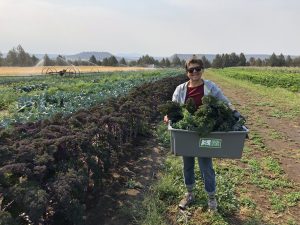 August and late July is when we collect the most, especially zucchini, our most popular collected item. If you’ve ever grown zucchini, you know they just fruit and fruit and fruit. So we get thousands of pounds of zucchini in a week alone during the height of the season. In the beginning, we get a lot of leafy greens. Numbers come in slow because we measure in pounds, we start with a lot of lighter crops. According to NeighborImpact, they don’t get a lot of leafy greens from other partners because it’s not shelf stable or bulky to get big amounts of food out to people. We are their outlets for fresh greens besides what they get from grocery hauls. So that’s something we are trying to focus on. Things like berries are also really incredible and provide a diversified offering to food pantry clients.
August and late July is when we collect the most, especially zucchini, our most popular collected item. If you’ve ever grown zucchini, you know they just fruit and fruit and fruit. So we get thousands of pounds of zucchini in a week alone during the height of the season. In the beginning, we get a lot of leafy greens. Numbers come in slow because we measure in pounds, we start with a lot of lighter crops. According to NeighborImpact, they don’t get a lot of leafy greens from other partners because it’s not shelf stable or bulky to get big amounts of food out to people. We are their outlets for fresh greens besides what they get from grocery hauls. So that’s something we are trying to focus on. Things like berries are also really incredible and provide a diversified offering to food pantry clients.
Coming into the end of the season, we will have a lot more gleaning events for farmers cleaning out their fields. We only have about a month and half of growing left, so we’ll get heavier crops like potatoes squash, pumpkins, onions start coming in. We have a few fruit tree gleans we are trying to expand as well.
Most of the produce is from farmers. Gardener outreach is new and we haven’t been focusing on it, but we know it’s there. Bulk of our collection is from farmers markets, left over from farmers and then the gleaning happens as needed. Farmers will reach out when they need volunteers. We have one farm we visit once a week. Other times, it’s off the cuff, like “we have a lot of broccoli, can you pick it up?” So we have these systems in place and always pivot quickly. That’s what working with fresh food is like.
UA: Sounds like Grow and Give fills a critical gap within the food bank and pantry system with fresh produce. I’d love to hear more about how the garden based collection program is evolving and what your vision is moving forward.
RL: It’s always been available for gardeners, we just haven’t focused efforts to make sure people know that. So that’s been the biggest shift, to make that a priority for outreach.
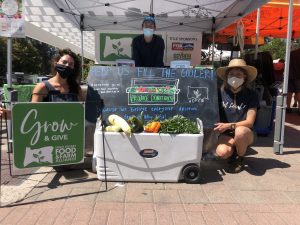 CD: It has been a slow start as farmers take priority in the heavy growing season. We go to community gardens to share about the program, share flyers, and be more of a presence so people know of us. We have been at farmers markets for years, and just this year put out sign that says “produce donations accepted here” because farmers have been how we thought about donations. Just thinking more about how gardeners might see and learn about Grow and Give.
CD: It has been a slow start as farmers take priority in the heavy growing season. We go to community gardens to share about the program, share flyers, and be more of a presence so people know of us. We have been at farmers markets for years, and just this year put out sign that says “produce donations accepted here” because farmers have been how we thought about donations. Just thinking more about how gardeners might see and learn about Grow and Give.
UA: What would you want smaller gardeners to know about donating to Grow and Give at farmers markets or throughout the year?
RL: No amount is too small to donate – that’s really important. If a gardener has extra zucchini or something and going to a farmers market, bring it with you to donate. We do say, if you wouldn’t eat it, we’re not looking to collect it. We’re not here to collect food that’s not edible – with bugs or major bruising. There are lines, collecting beans that are a little past their prime or some ugly produce is acceptable.
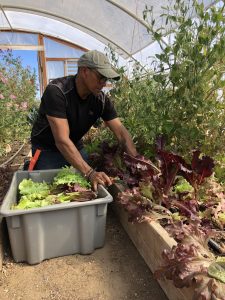
When farmers markets are over, pantries accept produce directly, look on the NeighborImpact site which lists all the pantries. If there are larger donations, we are able to pick it up with volunteers that pick up directly from gardens or houses if it’s a significant amount. We started a program this year, Veggie Haulers, and hope to expand. They are people on call for that reason, they are on call to pick up produce and bring it back to NeighborImpact.
We also have harvest events where we get volunteers, depending on what we’re harvesting that day, you can learn about those plants directly from farmers. So it’s great way to get involved.
CD: We accept donations from Bend and NWX Farmers Markets and CROP Farmers Market in Prineville.
UA: Are there requirements to be food pantry clients? Who is able to access the food that is collected.
RL: That is up to pantries themselves. Most pantries we’ve worked with are no barrier pantries, meaning clients don’t have to provide proof of income. You can show up and get what you need. We do have one program that has a few qualifications. The Veggie Rx program, with a registered dietitian on staff. This is another food access program, to qualify clients have a diet modifiable disease like diabetes, pre diabetes, heart disease, or obesity and self identify as food insecure. Again, not checking on proof of income there. This is the only food access program with a little more of a qualification aspect. For most pantries we work with for Grow and Give, don’t have restrictions other than to maybe come in once a week. All of that info is on the NeighborImpact site.
UA: With the increased unemployment and food supplies disruption related to the pandemic, I understand there have been a significant increase in demand for access to fresh food in some communities, what has been the impact of Grow and Give or has the program been impact impacted in that context?
RL: When COVID was starting in 2020, we noticed that farmers had the potential to lose markets from restaurant and wholesale accounts. We pivoted and raised money quickly to reimburse farmers for their contributions. It’s an opt out program, so we say “we’re going to reimburse you” and some farmers say “we don’t need the reimbursement.” So it’s more than a donation program, we are providing some income back to farmers. We keep track of everything and at the end of the season we dole out funds to everyone that has contributed. That was huge and we saw that farmers really value that.
We raised emergency funding to be able to that. Now we have secured funding to keep that piece going the next three years as a new permanent part of Grow and Give that came as a result of COVID. The hope is that incentivizes farmers to donate or contribute produce to increase the amount of produce we collect.
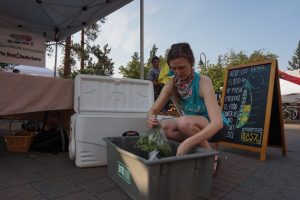 Our typical goal is to collect 15,000 pounds per year. Last year was a funky year and we didn’t quite meet our goal – we were at 13,500 pounds. And collected more salad greens than ever before. This year, we are already at 17,000 pounds and will definitely get to 20,000 which will be the most we collect in a single year! This is partially because people see the state of the world and see more food insecure people. We also have the incentives in place and doing more direct farm pickups. While we see an increase in people likely experiencing food insecurity, we are also seeing an increase in the amount food donated. Part of it is that the program is reaching its fifth year, so we are getting our legs under us and able to expand as well. We have partnered with NeighborImpact and use a refrigerated truck as needed. We weren’t able to have that as a small profit, but the ability to use it has been so important for our partnerships with farms. I would say that food banks themselves haven’t seen a huge increase in demand yet. A lot of that is related to a hold on evictions and electricity bills, as rent and bills become due we see the need increasing more so now than in the last year.
Our typical goal is to collect 15,000 pounds per year. Last year was a funky year and we didn’t quite meet our goal – we were at 13,500 pounds. And collected more salad greens than ever before. This year, we are already at 17,000 pounds and will definitely get to 20,000 which will be the most we collect in a single year! This is partially because people see the state of the world and see more food insecure people. We also have the incentives in place and doing more direct farm pickups. While we see an increase in people likely experiencing food insecurity, we are also seeing an increase in the amount food donated. Part of it is that the program is reaching its fifth year, so we are getting our legs under us and able to expand as well. We have partnered with NeighborImpact and use a refrigerated truck as needed. We weren’t able to have that as a small profit, but the ability to use it has been so important for our partnerships with farms. I would say that food banks themselves haven’t seen a huge increase in demand yet. A lot of that is related to a hold on evictions and electricity bills, as rent and bills become due we see the need increasing more so now than in the last year.
UA: Thanks for shedding some light on that, it seems like an important area to keep our eyes on. As we wrap up, is there anything you want to add that we didn’t have a chance to talk about?
RL: One piece of Grow and Give are Fresh Harvest Kits. It’s a cool concept and we’re looking to expand. It’s currently available in Bend, Sisters and Prineville. Fresh Harvest Kits are ready to make meal kits similar to Hello Fresh and Blue Apron. It includes produce from our partner farmers, we provide packing, spice packets, and recipes, pantries provide pantry staples like canned items. They are free to pantry clients and don’t need to qualify for anything. They are first come, first served. It takes common pantry staples like canned foods and pastas, and find ways to add nutrients with fresh produce.
One, they may introduce someone to a new vegetable they haven’t tried, and it teaches a new skill. Generally include items that people have seen and are working to include foods that are culturally appropriate for a more diverse range of people and have materials available in English and Spanish. We see that being extremely important going forward. We have high hopes for working with folks to expand to Madras.
Photos courtesy of High Desert Food and Farm Alliance.